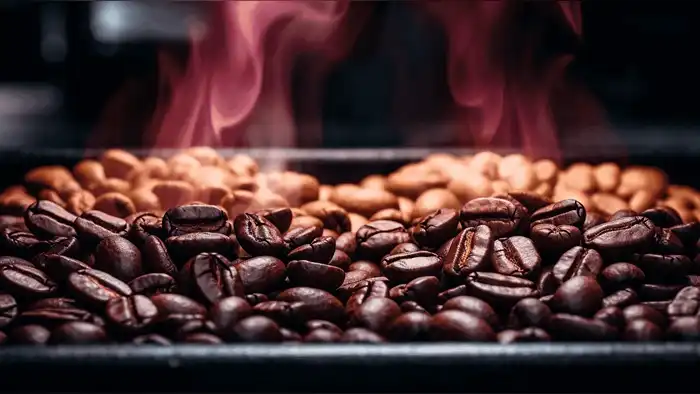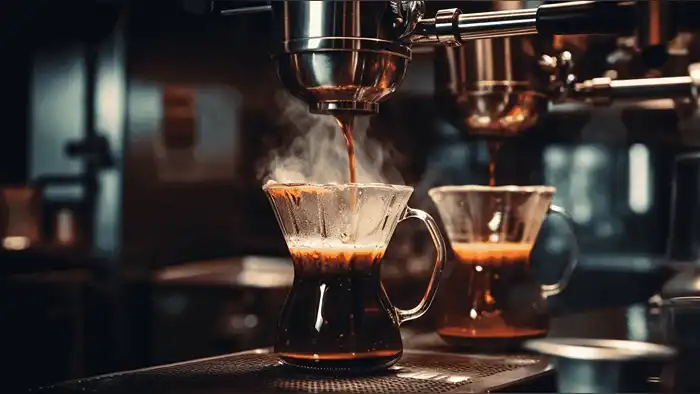Are you torn between blend coffee and single origin? Wondering about the differences in taste, roasting methods, aroma, brewing techniques, environmental impact, price, and availability? Look no further!
In this article, we’ll break down the pros and cons of blend coffee versus single origin. Discover which option suits your preferences and learn how each one affects your daily java experience.
So grab a cup of joe and let’s dive into the world of Blend Coffee Vs Single Origin!
In this concise table, we dissect their diverse characteristics – from taste to environmental impact – igniting your curiosity to delve deeper. Whether you’re a seasoned sipper or just starting your coffee odyssey, this table offers a tantalizing glimpse into the art and science that elevate your daily brew.
| Aspect | Blend Coffee | Single Origin Coffee |
|---|---|---|
| Taste | More complex flavor profile | Straightforward taste experience |
| Composition | Combination of beans from various regions | Sourced from one specific region or farm |
| Flavor Notes | Chocolate, caramel, fruitiness, hints of spice | Showcasing unique qualities of a particular area |
| Roasting Expertise | Crafted by many roasters | Crafted by expert roasters |
| Characteristics | Well-rounded and consistent cup | Unique qualities and terroir of the specific region |
| Overall Flavor Experience | Smooth yet bold, layers of flavors | Delicious but simpler flavor profile |
| Roast Level | Can vary from light to dark roast | Often lighter roast to highlight unique flavors |
| Development Time | May have longer development times for balance | Usually shorter development times for uniqueness |
| Heat Application | Different methods applied, impacting nuances | Various approaches for flavor complexity |
| Acidity | Can vary depending on the beans and roast level | Often higher acidity, showcasing origin’s uniqueness |
| Body | Can range from light to heavy | Often lighter body, allowing origin characteristics to shine through |
| Complexity | Achieves complexity through blending various beans | Showcases inherent complexity through careful roasting |
| Consistency | Can maintain consistent flavor year-round | Flavor may vary with each harvest, showcasing seasonal variations |
| Origin Exploration | May not highlight specific origin characteristics | Allows exploration of a region’s distinct coffee flavors |
| Aroma | Rich and complex fragrance, harmonious mix of scents | Distinct characteristics of specific region’s terroir |
| Bean Source | Different types of beans from various regions | Sourced from one specific region or farm |
| Aroma Profile | Crafted by expert roasters, scents like chocolate, caramel, nuts | Pronounced and focused aromas, floral, fruity, earthy notes |
| Experimentation | Suitable for various brewing techniques | Ideal for exploring distinct flavor profiles |
| Environmental Impact | Blend coffee often consists of beans from multiple regions, increasing carbon emissions and contributing to global warming | Single origin coffee is sourced from one specific location, reducing carbon footprint from transportation |
| Farming Methods | Blend coffee may involve a mix of farming methods | Single origin often involves sustainable methods like organic and shade-grown techniques, promoting biodiversity and protecting habitats |
| Certifications | May not always have specific certifications | Often associated with certifications like Fair Trade or Rainforest Alliance, ensuring ethical and environmentally friendly practices |
| Price | More budget-friendly | Pricier due to uniqueness |
| Availability | More readily available | Limited availability |
| Production Costs | Lower due to lower-cost beans | Higher due to cultivation attention |
| Distribution | Widely distributed | Niche market |
| Convenience | Common in grocery stores and cafes | May require specialty shops |
| Suitability for Budget | Affordable and economical | Higher cost, better quality |
| Suitability for Variety | Offers a wide range of options | Limited selection |
Dive into the captivating world of coffee, comparing the harmonious blends to the unique single origins. As you savor the diverse flavors, why not explore the Elite Class of Coffee Beans and discover the luxury behind every bean?
The Difference in Taste

When it comes to taste, you’ll notice that blend coffee offers a more complex flavor profile compared to single origin. Blends are carefully crafted by expert roasters who combine different types of beans from various regions to achieve a unique and balanced flavor.
This combination allows for a harmonious blend of flavors that can include notes of chocolate, caramel, fruitiness, and even hints of spice.
The beauty of blend coffee lies in its ability to create a well-rounded and consistent cup of joe. Each component bean adds its own distinct characteristics, contributing to the overall complexity and depth of flavor. The result is a coffee that is smooth yet bold, with layers of flavors that dance on your palate.
On the other hand, single origin coffees offer a more straightforward taste experience. These coffees are sourced from one specific region or farm, showcasing the unique qualities and terroir of that particular area.
While single origin coffees can be incredibly delicious in their own right, they tend to have a simpler flavor profile compared to blends.
Why not put your taste buds to the test? Consider conducting a [Coffee Blends vs. Instant Taste Test]. Brew a cup of your favorite blend coffee alongside an instant coffee option.
Take a moment to savor each sip, paying attention to the subtle notes and bold flavors that distinguish the two. This taste test can be a fun and enlightening way to explore the nuances of different coffee types and discover your personal preferences.
Roasting Methods

Although roasting methods vary, they can greatly impact the flavors of different coffees. When it comes to the debate between blend coffee and single origin, understanding how each is roasted can help you make an informed choice.
Here are three ways that roasting methods can influence the taste of your coffee:
- Roast Level: The roast level determines how long the beans are roasted and at what temperature. Lighter roasts retain more of their natural flavors and acidity, while darker roasts develop bolder, smokier flavors. So, if you prefer a bright and vibrant cup of coffee, you might lean towards a light roast single origin. On the other hand, if you enjoy a rich and robust flavor with caramel or chocolate undertones, a dark roast blend might be more up your alley.
- Development Time: This refers to how long the beans are kept in contact with heat during the roasting process. A longer development time leads to more complex flavors as sugars caramelize and oils emerge from within the beans. Single origins often undergo shorter development times to highlight their unique characteristics, while blends may have longer development times for a balanced flavor profile.
- Heat Application: The way heat is applied during roasting also affects the final taste of your coffee. Some methods involve applying high heat initially for a fast roast while others use lower temperatures throughout for slower development of flavors. Each approach brings out different nuances in both blends and single origins.
If you’re intrigued by the science of roasting and want to learn more about coffee bean origins, take a journey to coffee’s birthplace unveiled.
Aroma Comparison
[youtube]https://youtu.be/nxvt-PLf8oA[/youtube]
To fully appreciate the aroma of each, take a moment to compare blend and single origin coffees.
When it comes to blends, you can expect a rich and complex fragrance that tantalizes your senses. The art of blending involves combining different types of beans from various regions.
This results in a unique aroma profile that is carefully crafted by expert roasters. With blend coffees, you may experience a harmonious mix of scents like chocolate, caramel, and nuts.
On the other hand, single origin coffees offer a different aromatic experience altogether. These coffees are sourced from one specific region or farm, allowing you to enjoy the distinct characteristics of that particular area’s terroir.
Single origin coffees often have a more pronounced and focused aroma compared to blends. You might encounter fragrances like floral notes, fruity undertones, or earthy hints depending on the origin.
By comparing the aromas of blend and single origin coffees side by side, you can truly understand their differences. It’s fascinating how blends showcase complexity through their well-balanced aromas while single origins highlight the unique qualities of specific regions or farms.
So go ahead and indulge your senses in these delightful scents – whether it’s the captivating blend or the intriguing single origin – there’s an aromatic journey waiting for you in every sip!
While the distinction between blend and single origin coffees is captivating, there’s also a vast array of coffee blends that combine different beans for unique flavors. Dive into the understanding Arabica and Robusta blends to see how these beans come together for a distinct taste experience.
To fully appreciate the aroma of each, take a moment to compare blend and single origin coffees. Learn more about the art of mastering Mocha Java blends and the nuances of different scents.
Brewing Techniques

Discover the different brewing techniques for blend and single origin coffees, and enhance your coffee experience. When it comes to brewing coffee, understanding the techniques for blend and single origin coffees can make a significant difference in the taste and aroma of your cup.
Both types have their own unique characteristics, so let’s explore how to bring out the best flavors from each.
| Brewing Technique | Blend Coffee | Single Origin Coffee |
|---|---|---|
| French Press | ✔️ Often produces a robust and well-rounded flavor profile by blending different beans. | ✔️ Enhances the distinct regional characteristics and nuanced flavors. |
| Pour Over | ✔️ Blending beans results in a balanced and flavorful cup. | ✔️ Highlights the unique flavor notes and terroir of a specific region. |
| Espresso | ✔️ Offers consistent shots with rich crema, great for espresso enthusiasts. | ✖️ Generally not used for single origins due to their delicate flavors. |
| Cold Brew | ✔️ Blends can provide bold and lasting flavors, suitable for extended steeping. | ✖️ Not typically used for single origins as their subtleties may be lost. |
| AeroPress | ✔️ Allows flexibility in experimenting with blend ratios for different flavors. | ✔️ Can bring out the delicate flavors and aromatics of single origin beans. |
| Siphon | ✔️ Showcases the complexity of blend flavors through vapor pressure. | ✔️ Can highlight the unique characteristics of single origin beans. |
| Chemex | ✔️ Blends can yield a well-balanced and clean cup. | ✔️ Reveals the intricate flavors and subtleties of single origin coffee. |
| Moka Pot | ✔️ Blends can create a rich and concentrated coffee. | ✔️ Works well for single origins with a robust flavor profile. |
For blend coffees, you can use various brewing methods such as French press or pour-over to extract a balanced flavor profile. These methods allow the different beans in the blend to complement each other, creating a harmonious taste experience.
On the other hand, single origin coffees are often more delicate in flavor and showcase specific regional characteristics. They tend to shine when brewed using methods that highlight their unique qualities, like pour-over or French press.
While both blends and single origins can be enjoyed with most brewing techniques, espresso lovers may lean towards blends due to their ability to provide consistent shots with rich crema.
Cold brew enthusiasts also prefer blends as they tend to produce bolder flavors that hold up well during extended steeping periods. Ultimately, experimenting with different brewing techniques will help you find your perfect cup of coffee based on your preferences for either blends or single origins.
Environmental Impact

When it comes to the environmental impact of your brewing choices, you can make a difference by choosing sustainable practices.
When comparing blend coffee and single origin in terms of their environmental impact, there are a few key factors to consider.
Firstly, blend coffee often consists of beans sourced from multiple regions or farms. This means that the transportation required to bring these beans together increases carbon emissions and contributes to global warming.
On the other hand, single origin coffee is sourced from one specific location, reducing the carbon footprint associated with transportation.
In addition to transportation, the farming methods used for growing coffee also play a significant role in its environmental impact.
Many sustainable farmers who produce single origin coffee opt for organic and shade-grown techniques. These methods promote biodiversity and protect natural habitats, ensuring a healthy ecosystem for wildlife.
Furthermore, when purchasing coffee, it is essential to look for certifications such as Fair Trade or Rainforest Alliance.
These certifications guarantee that the farmers were paid fair wages and that environmentally friendly practices were followed throughout the production process.
By choosing sustainable brewing practices such as opting for single origin coffee sourced through ethical means and supporting certified producers, you can reduce your environmental impact while enjoying a delicious cup of joe.
Your conscious decision can contribute towards protecting our planet’s resources for future generations to come.
Price and Availability

If you’re looking for a more affordable option, consider exploring the price and availability of blend coffee versus single origin.
When it comes to cost, blends are often more budget-friendly than single origin coffees. Blends are created by combining beans from different regions, which allows roasters to use lower-cost beans without compromising on taste. This means that you can enjoy a flavorful cup of coffee without breaking the bank.
Additionally, blends are usually easier to find and more readily available compared to single origin coffees. They are commonly found in grocery stores and cafes, making them convenient options for everyday consumption.
Single origin coffees, on the other hand, tend to be pricier due to their limited availability and unique flavor profiles. These beans come from a specific region or farm, resulting in distinct tastes that coffee enthusiasts appreciate.
However, because they require more attention during cultivation and have higher production costs, they generally come with a higher price tag. Single origin coffees are also not as widely distributed as blends since they cater to a niche market.
Ultimately, the choice between blend coffee and single origin depends on your preferences and budget. If you’re looking for an affordable option that is easily accessible, blends are the way to go.
But if you value unique flavors and don’t mind spending a bit extra for quality beans, then exploring single origin coffees might be worth considering.
Frequently Asked Questions
What Are the Health Benefits of Drinking Blend Coffee Compared to Single Origin?
Drinking blend coffee offers a variety of health benefits compared to single origin. It combines different flavors and strengths, providing a balanced taste. This versatility can enhance your coffee experience and cater to your individual preferences.
How Does the Acidity Level Differ Between Blend Coffee and Single Origin?
The acidity level can vary between blend coffee and single origin. It’s important to note that blends often have a balanced acidity, while single origin coffees may have more pronounced or nuanced flavors.
Can You Explain the Difference in Caffeine Content Between Blend Coffee and Single Origin?
Blend coffee and single origin differ in caffeine content. In blend coffee, the caffeine level may vary as it combines different beans. Single origin has a consistent caffeine content from beans grown in one region.
Are There Any Specific Recommendations for Pairing Food With Blend Coffee and Single Origin?
When it comes to pairing food with blend coffee and single origin, there are no specific recommendations. It ultimately depends on your personal taste preferences and what flavors you think will complement each other.
How Do Blend Coffee and Single Origin Beans Differ in Terms of Their Origin and Sourcing Practices?
Blend coffee and single origin beans differ in terms of their origin and sourcing practices. The blend coffee is a mixture of different beans while the single origin comes from one specific region, offering a unique flavor profile.
Best Coffee Blend Picks
Blend coffee is a combination of different coffee beans from various regions, carefully selected and blended to create a unique taste. This process involves expertly crafting a fusion that highlights the strengths of each component bean.
The beauty of blend coffee lies in its ability to bring together different flavor profiles, creating a harmonious and balanced cup of joe. The interplay of various beans contributes to a symphony of flavors that dance on your palate with each sip.
With blend coffee, you get the best of both worlds – the boldness and richness of one bean complemented by the subtle nuances of another. It’s like experiencing a delightful conversation between coffee varieties.
This results in a more complex and interesting flavor experience compared to single-origin coffee. For those seeking a coffee adventure that transcends the ordinary, explore the realm of Premium Gourmet Coffee Blends that offer a blend of craftsmanship and flavor.

